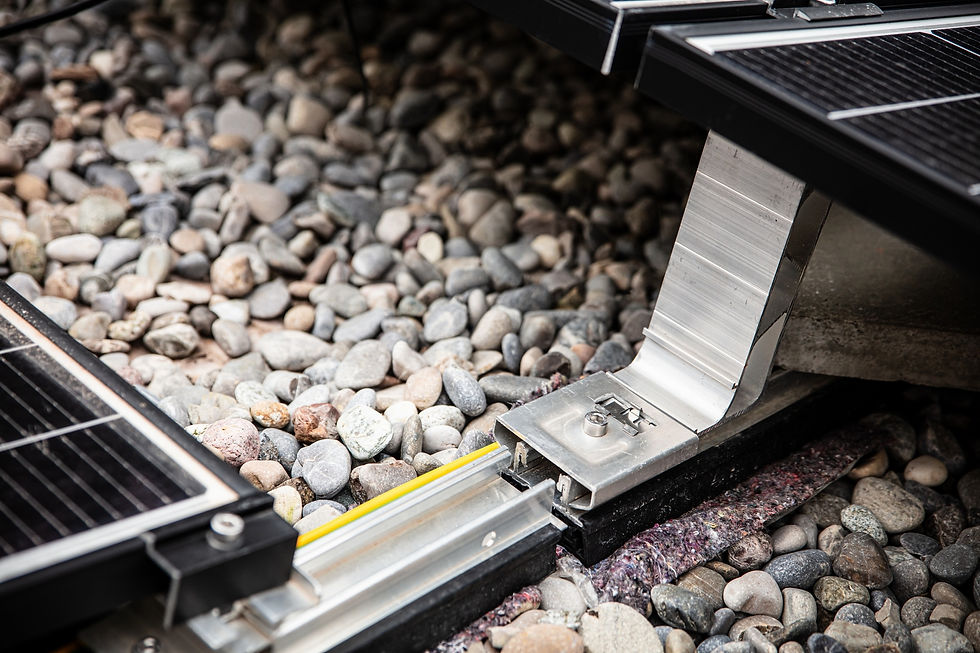Solar Panels on Gravel Roofs: Challenges and a Smarter Alternative
- Over Easy Solar
- Jul 8
- 4 min read
Updated: Jul 31
Flat roofs covered with gravel are common across Europe. These roofs offer large, unused surfaces perfect for solar energy generation. But installing traditional solar systems is often difficult or even impossible.

Installing solar panels on gravel roofs
Gravel roofs serve several functions: they protect the waterproofing membrane from UV damage, provide thermal mass, and reduce wind uplift. But they also pose challenges when integrating solar. Typical gravel layers are 5–10 cm thick, and roofs are often designed with minimal excess load capacity. That makes any additional weight – like ballasted solar systems – a structural concern.
It's also important to distinguish between different types of gravel roofs. Some are standard protected membrane systems, while others are inverted roofs where the insulation lies above the membrane and under the gravel. Inverted roofs in particular can be very difficult to work with when using conventional PV mounting systems, as the upper surface below the gravel is not a typical interface to work with for conventional mounting systems.
Conventional mounting systems and their limitations
Standard PV mounting systems from suppliers like K2 Systems, Novotegra, Esdec, PanelClaw, and IBC Solar are designed for flat roofs. They use ballast blocks to avoid roof anchoring. While some systems allow placement over gravel, most require local gravel removal and direct placement on the interface below the gravel.

The gravel layer thickness of 5-10 cm also can present a problem for the systems, because the clearance under the solar panels is normally only around 5 cm on these systems.
These systems also demand detailed wind-load and ballast calculations, to counter for both lift forces and push forces. In high wind zones, small surfaces or on taller buildings, ballast requirements rise significantly. Even when carefully designed, these systems may exceed what the roof can safely support.
The misconception of "Removing gravel to make room for PV"
For roofs with load-bearing limitations, you might think about removing some of the gravel. It seems logical: If you remove 25 kg of gravel per square meter, can you replace it with 25 kg of solar ballast? Not really. Gravel applies a uniform dead load across the entire roof. In contrast, ballasted PV systems apply point loads under mounting feet and must resist wind uplift forces. These concentrated loads stress the roof differently and cannot be offset by simply removing gravel.
Structural engineers do not accept this tradeoff. Replacing gravel with solar ballast without structural assessment can lead to membrane damage, deformation, or safety risks.
Maintenance need of gravel roofs with solar
Gravel roofs require regular maintenance. Drains must remain clear, the membrane must be inspected occasionally, and vegetation growth must be controlled. Over time, dust and organic matter allow weeds and moss to grow between gravel stones. Intrusive vegetation must be removed, otherwise it can damage the roof and create long-term problems from root intrusion or blocked drains.
Traditional ballasted solar systems can obstruct access to drainage points and make inspections and maintenance difficult. They often cover large areas of the roof surface, making it harder to remove vegetation or detect early signs of damage. If the roof membrane needs repair during the life of the PV system, removing and reinstalling heavy ballasted panels adds significant time and cost.
When the appearance of the roof counts
While gravel roofs are often chosen for practical reasons, they are also sometimes selected for their visual appearance. The light-colored stone finish gives the roof a clean, uniform look that complements many commercial and institutional buildings. Over Easy Solar’s VPV system maintains this aesthetic: its vertical layout and spaced configuration allow most of the gravel surface to remain visible. Unlike traditional systems that blanket the roof with modules and ballast blocks, the VPV unit preserves the open, minimalist character of the roof. In fact, the light-colored gravel has an additional benefit — it reflects sunlight onto the bifacial panels, boosting energy production and contributing to higher overall system performance.

A smarter alternative – Over Easy Solar’s VPV Unit
Over Easy Solar’s vertical bifacial PV (VPV) system is designed specifically for challenging rooftops, including gravel-covered roofs with limited load capacity. The system is ballast-free and lightweight. It is installed without roof penetrations and requires only local gravel removal to place the mounting feet.
The vertical design not only improves wind stability but also allows light capture from both the east and west. This increases energy production during high-value morning and afternoon hours. The system leaves the majority of the roof surface open and walkable, preserving access to drains and making maintenance easy.
The high mounting system creates 10 cm clearance between the bottom edge of the panel and the roof surface – ideal for typical gravel layers of 5–10 cm. This means the gravel can remain undisturbed between rows, and airflow beneath the panels helps reduce dirt buildup.
Choosing the right solar solution for gravel roofs
Gravel roofs present both a challenge and an opportunity. Traditional ballasted PV systems are often too heavy, too invasive, and too hard to maintain for these structures. Removing gravel does not solve the problem.
Over Easy Solar’s VPV unit offers a purpose-built solution: ballast-free, membrane-friendly, and installer-approved. For building owners with gravel roofs and structural limitations, it’s the clearest path to unlocking solar potential without compromising safety, maintenance access, or roof integrity.
A recent example of an Over Easy Solar installation is one done by Solarmobility and Planpro in Vufflens-la-Ville in Switzerland in 2025:
Over Easy Solar's solution is the only suitable for this flat roof because we couldn't install anchors; the insulation is 20 cm thick polyurethane foam; nor could we load the roof with ballast.
François Calame, CEO & Founder, Solarmobility Sarl









